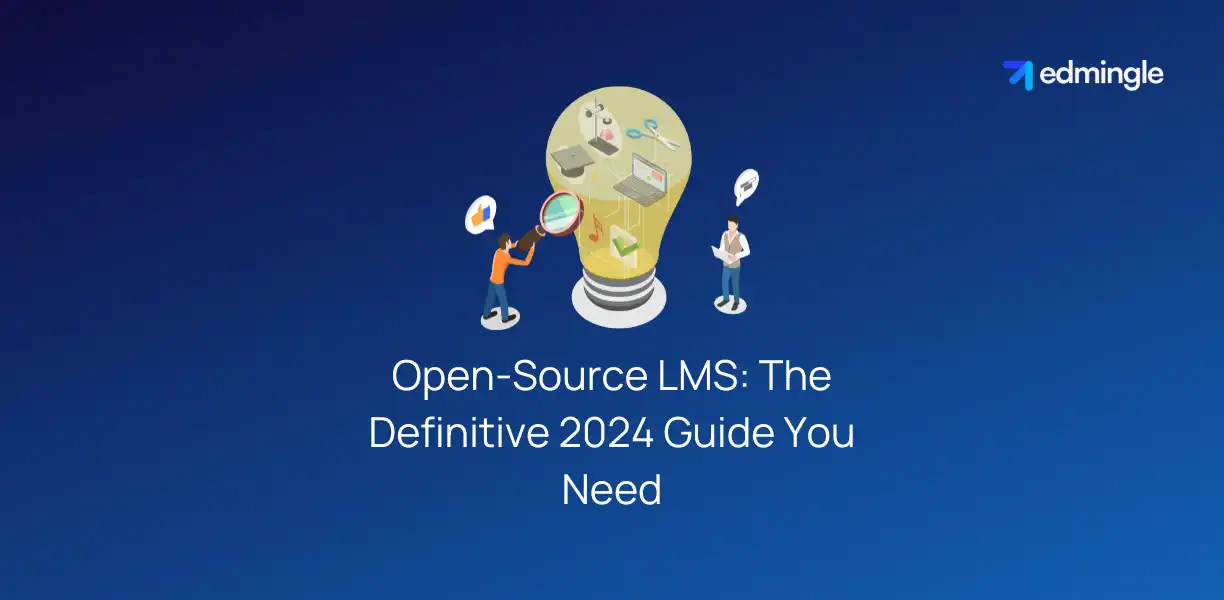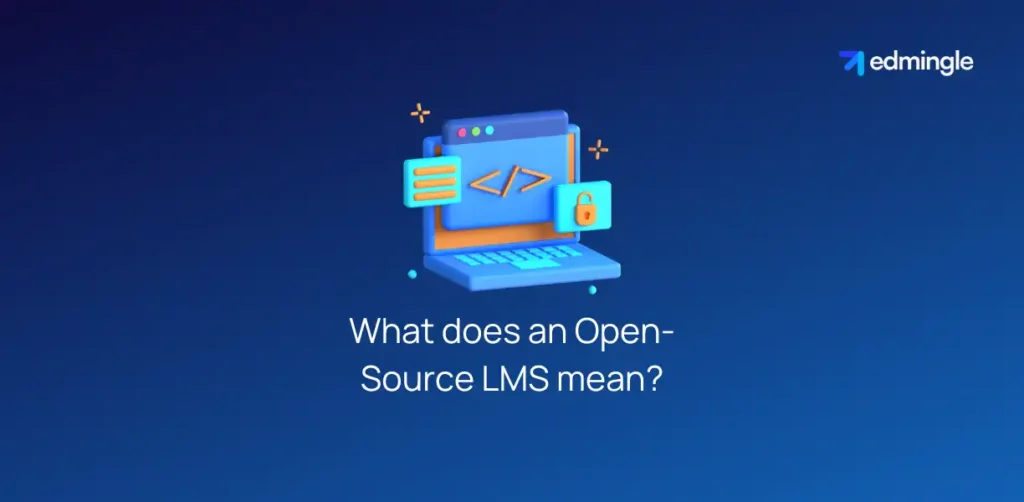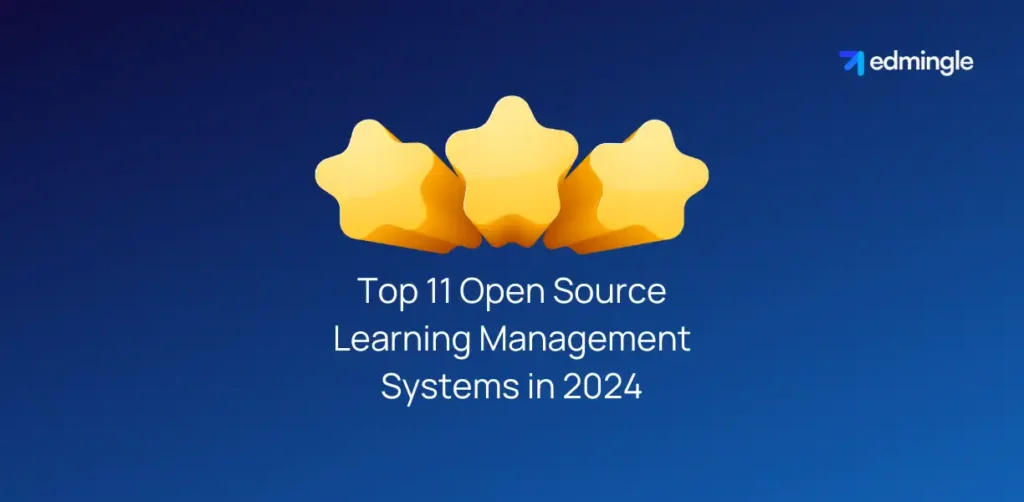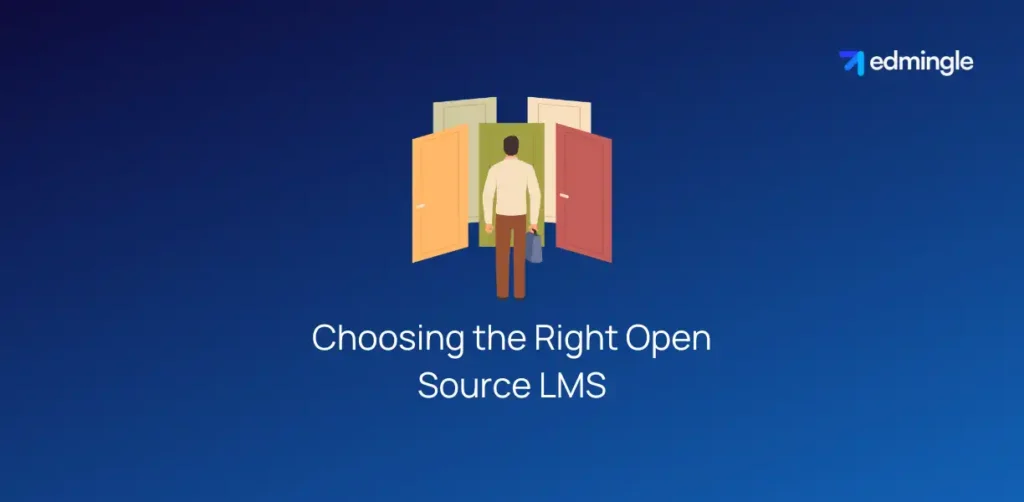
Who doesn’t want adaptable & accessible learning solutions? Especially when the world is constantly facing economic hardships; cost-effective solutions are in higher demand than ever before.
And to perfectly suit this, an open-source LMS opens doors to endless possibilities. A world where flexibility rules above all else.
In this blog, we embark on a journey into the heart of open source learning management systems. Exploring the benefits it brings, limitations it faces and more.
What does an Open Source LMS mean?

An open-source LMS is just like any regular learning management system. With a difference that the source code is freely available for anyone to view and modify.
This encourages collaboration & innovation by allowing educational institutions, educators & developers. To customize the platform according to their specific needs.
Without the constraints of licensing fees or proprietary restrictions.
Open source learning management system platforms facilitate a wide range of learning activities. From online courses to certifications. All while fostering a community-driven approach.
Also read about Best Free LMS.
7 Key Benefits of Using an Open Source Learning Management System
The adoption of an open-source software for learning management offers a plethora of benefits. The power of community-driven innovation being a major one.
These online learning platforms help in democratizing education with the following key benefits:
| 1.Customization and Flexibility: They stand out for their unparalleled flexibility. Majorly for allowing users to tailor the software to their unique educational requirements. This ensures that they can mold the platform to fit their curriculum. Rather than adjusting their teaching methods to suit the software. | 2.Cost-Effectiveness: One of the most compelling advantages is the elimination of licensing fees. With no costs associated with purchasing/renewing software licenses. Institutions can allocate their resources more efficiently. This helps them invest in other critical areas. Such as content development or infrastructure improvement. |
| 3.Community Support: Behind every open-source LMS is a vibrant community. Full of developers, educators and enthusiasts. A majority of which is committed to improving & evolving the platform. This collective expertise offers users a rich reservoir of support. From troubleshooting technical issues to sharing best practices & innovative uses. | 4.Enhanced Security and Transparency: This might seem something different. But given the community support, anyone can examine the code for vulnerabilities. The community-driven development also ensures rapid response to security threats. |
| 5.Interoperability and Integration: Designed with interoperability in mind. These platforms facilitate integration with a wide array of educational tools and systems. This might come in the form of LMS plugins or add-ons. But the seamless integration offered by a SaaS LMS remains unmatched. | 6.Continuous Innovation: Since the community is huge, it fosters continuous innovation. Contributions from the global community lead to regular updates, new features & cutting-edge technologies. Being integrated into the platform. |
| 7.Ownership and Independence: Open-source means full ownership over your learning environment. Freed from vendor lock-in & proprietary limitations, educators & institutions can chart their own course. | |
In short, the adoption of an open-source LMS offers a strategic advantage. Especially because it leverages the collective wisdom of a global community.
Since we talked about cost-effectiveness, check our article on LMS pricing.
Important Limitations of an Open Source Learning Management System

While an open source learning management system offers a myriad of advantages. There also exist some crucial constraints that may not be deal-breakers. But rather considerations that must be weighed before implementing one.
Here are some of the important limitations that need a check:
1.Technical Expertise Requirement: Unlike proprietary solutions that come with dedicated customer support. These may require users to have a certain level of technical expertise or to seek external assistance. This could lead to additional costs.
2.Support and Maintenance: While the community support is robust, it lacks predictability and immediacy. Institutions may need to rely on discussion forums, community help or hire specialists for ongoing support and troubleshooting. Most of which can vary in expertise & responsiveness.
3.Resource Allocation for Development: Customizing & updating an open-source LMS can be resource-intensive. Especially when its done to meet specific needs or to keep up with evolving e-learning trends.
4.Compatibility and Integration Challenges: Although they are designed for flexibility. Integration with existing systems or third-party tools can present challenges. Ensuring compatibility and seamless operation requires diligent planning and testing.
5.Learning Curve for Users: Transitioning from proprietary to an open-source LMS might come with a steep learning curve. A user-friendly interface and functionality can vary significantly. Necessitating training and adaptation time to achieve proficiency.
6.Varied Quality of Plugins and Add-ons: The open-source ecosystem thrives on community-contributed plugins and add-ons. These extend the functionality of the LMS. However, the quality and reliability of these contributions can vary. Requiring thorough vetting to ensure they meet institutional standards & are maintained over time.
7.Security Responsibility: While open-source solutions are transparent in nature and is under community vigilance. Organizations will have to take on a greater responsibility for their security measures. Regular updates & security patches need to be managed diligently to safeguard against vulnerabilities.
8.Payment Gateway Integration: Since these aren’t readily available as an end-to-end solution. The user might have to take on the responsibility for any payment gateways they prefer to add-on.
Understanding these limitations is key to leveraging the full potential of open-source LMS platforms. By acknowledging these challenges & planning accordingly you can capitalize on its strengths. While mitigating its drawbacks.
Also read about LMS integrations and LMS security features.
Open Source LMS vs Cloud Based LMS

While both represent two distinct paradigms in the world of e-learning platforms. Each with its unique advantages and considerations.
While the former offers unparalleled flexibility and control, the latter is hosted on the provider’s servers. Thus, requiring less technical involvement from the user’s side. While also offering scalability, reliability and ease of use.
The star highlight being the provider handling updates, security & maintenance in cloud-based LMSs.
A choice between them depends on an organization’s priorities, resources and technical capabilities. As most modern cloud based LMSs come with customization flexibility and 100% control.
In-depth Article: Cloud-Based LMS vs Open-Source LMS.
Top 11 Open Source Learning Management Systems in 2024

The landscape of open source learning management systems is diverse. Offering a range of solutions tailored to different educational needs and organizational sizes.
Here’s a look at the top 11 open-source LMS platforms in 2024.
1.Moodle
Moodle stands out for its comprehensive LMS feature set, extensive global community and flexibility. It’s a favored choice for both academic institutions and small businesses.
It also offers customizable themes, a wide range of plugins and a robust support for mobile learning.
2.Open edX
Open edX is renowned for its scalability and innovative course creation tools. This platform excels in delivering MOOCs and smaller private online education courses.
Featuring rich media support, interactive learning experiences and a strong analytics suite.
Also read our step-by-step guide on how to create an online course.
3.Canvas
Canvas offers a friendly user interface combined with a powerful set of teaching and learning tools. It provides seamless integration with a wide array of educational apps and resources.
Alongside comprehensive support for mobile devices. It helps create collaboration among learners. While creating an engaging learning environment for better learner engagement.
4.Chamilo
Chamilo is designed with a focus on ease of use, rapid deployment and scalability. It has a light resource footprint and intuitive interface. It supports a wide range of use cases, from traditional classrooms to corporate training.
You might also like to read about LMS for customer training.
5.Forma LMS
Forma LMS is targeted towards employee training, with a strong emphasis on talent management. It has a range of features like advanced user management, reporting and certificate generation capabilities.
It is particularly appreciated for its flexibility in supporting both online and blended learning paths.
6.ATutor
ATutor is a compact, yet powerful LMS focusing on accessibility and adaptability. It provides content authoring tools, course management and social networking features.
Its an excellent choice for organizations prioritizing inclusivity and standards compliance.
Also read about LMS for compliance training.
7.ILIAS
ILIAS goes beyond being just an LMS; it’s a fully integrated learning & collaboration system. It supports learning content management with its collaboration tools and testing & assessment modules.
Its suitable for a wide range of learning and training contexts, from universities to government agencies.
Related article: LMS vs LCMS.
8.Schoology
Schoology offers a comprehensive suite of learning management & social learning features. It facilitates an engaging user experience by allowing third-party integrations.
9.Paradiso
Paradiso LMS is known for its rich feature set and integrations with CRM, ERP and various other software. It offers a personalized learning experience with its AI-based recommendations and gamification strategies.
10.OpenLMS
OpenLMS leverages Moodle’s open-source platform to provide a fully managed LMS solution. It combines the flexibility of Moodle with additional & robust features and support.
It’s basically designed to reduce the complexity and resource requirements of managing a Moodle site.
11.Masteriyo LMS
Masteriyo LMS is a newcomer that focuses on simplicity and user-friendliness. All that without sacrificing functionality. It’s a WordPress-based solution, making it accessible to a wide audience looking to build and sell courses online.
Each of these open-source LMS platforms offers unique strengths. While catering to the varied needs of the educational and business sectors.
Choosing the Right Open Source LMS

Choosing the right open source LMS hinges on several critical factors. Especially when weighed against a cloud-based/SaaS LMS.
These factors depend mostly on your organization’s specific needs and goals. So, to help you make a well-informed decision, here’s a brief guide.
- Begin by assessing the technical capabilities of your team. As some platforms may require more technical expertise for customization & maintenance.
- Consider the scalability of the system to ensure it can grow with your organization. While accommodating an increasing number of users and online training courses. Read about Edmingle’s scalability & flexibility.
- Evaluate the features & functionalities that are crucial for your educational objectives. Such as assessment tools, mobile accessibility and integration capabilities with other software.
- Customer support & service is another vital aspect. Additionally, review the LMS’s security features and compliance with data protection regulations.
- Lastly, factor in the total cost of ownership. Including potential expenses for hosting & customization.
Selecting the right open-source LMS involves a balanced consideration of these elements. And this will ultimately get you a platform that aligns with your educational strategy & tech infrastructure.
Summary
From delving into the top platforms reshaping education to understanding the benefits & limitations. We’ve witnessed essential facets that make these systems a cornerstone of modern education.
As we move towards a better, inclusive future of education. The quest for adaptable, accessible & cost-effective learning solutions will grow manifolds in relevance.
Ultimately, choosing the right open-source LMS requires a thoughtful balance. One that is in perfect alignment with your learning process, needs, goals and vision.
FAQs on Open Source LMS
1.How does an open source LMS differ from proprietary LMS?
Open-source LMS software is freely available for customization and use. Whereas proprietary LMS platforms are owned by companies that charge for access and do not release the source code for public modification.
2.How secure is an open-source LMS?
Their open nature allows for continuous inspection and improvement by a global online community. However, a major part of handling security falls solely upon organizations. They must actively manage and update their installations to maintain security.
3.Is it free to use an open-source LMS?
While the software itself is free to use, there may be costs associated with hosting, customizing and maintaining the platform. Depending on the organization’s specific needs and resources.
4.Can you switch from a proprietary to an open-source LMS?
Yes, but the process requires careful planning, data migration and potentially custom development. To ensure that all educational materials and user data are successfully transferred & ultimately, seamlessly supported.

Leave a Reply